The Impact of COVID-19 on Crime: A Spatial Temporal Analysis in Chicago
Abstract
:1. Introduction
2. Related Work
2.1. Crime and COVID-19
2.2. Spatial and Temporal Crime Analysis
3. Materials and Methods
3.1. Workflow
3.2. Study Area and Data
3.3. Methods
3.3.1. Time Series Decomposition
3.3.2. Spatial Point Pattern Test
- Adopt crimes in 2020 as the base dataset and crimes in 2019 as the test dataset (the test detects spatial pattern variations of base dataset relative to test dataset).
- Randomly sample 85% of the test dataset 200 times, and then calculate the percentage of crimes in census tracts to generate a 95% confidence interval; and
- Determine whether the percentage of the basic data in the census tracts falls into the confidence interval, obtain the value of the local S-index, and calculate the global S-index.
4. Results and Analysis
4.1. Results
4.1.1. Criminal Temporal Patterns under the Effect of COVID-19
4.1.2. Criminal Spatial Patterns under the Effect of COVID-19
4.2. Spatial and Temporal Analysis
4.2.1. Temporal Analysis
4.2.2. Spatial Analysis
5. Discussion and Conclusion
Author Contributions
Funding
Conflicts of Interest
Appendix A
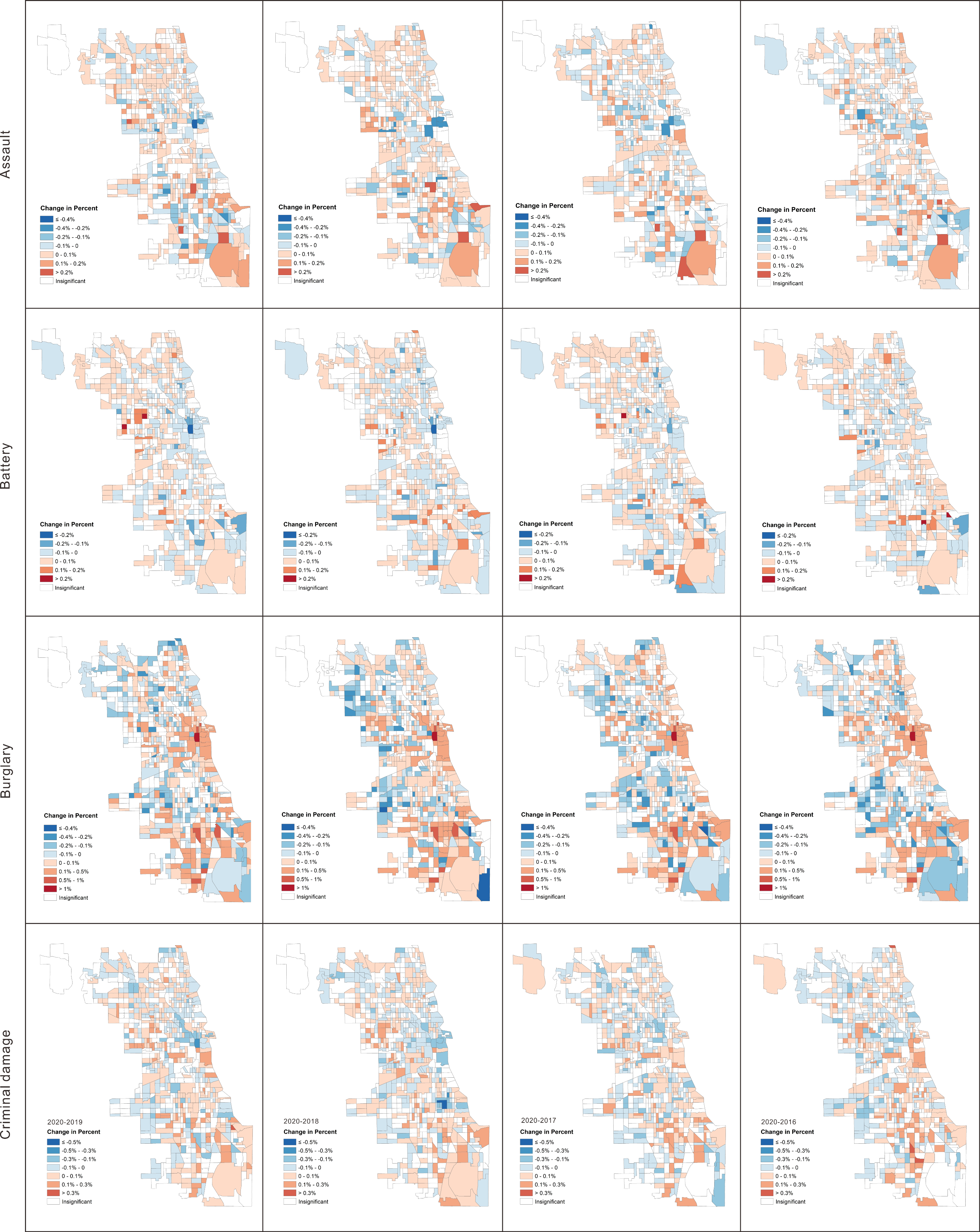

| Base-Test (Dataset) | Theft | Robbery | Assault | Battery | Burglary | Criminal Damage | Fraud |
|---|---|---|---|---|---|---|---|
| 2020-2019 | 0.282 | 0.402 | 0.357 | 0.367 | 0.316 | 0.31 | 0.317 |
| 2020-2018 | 0.242 | 0.341 | 0.351 | 0.343 | 0.297 | 0.306 | 0.297 |
| 2020-2017 | 0.222 | 0.372 | 0.367 | 0.337 | 0.291 | 0.311 | 0.311 |
| 2020-2016 | 0.238 | 0.356 | 0.353 | 0.310 | 0286 | 0.316 | 0.301 |
| 2019-2018 | 0.337 | 0.383 | 0.372 | 0.355 | 0.325 | 0.197 | 0.352 |
| 2019-2017 | 0.321 | 0.386 | 0.366 | 0.370 | 0.301 | 0.288 | 0.367 |
| 2019-2016 | 0.301 | 0.358 | 0.330 | 0.342 | 0.325 | 0.320 | 0.343 |
References
- Yang, C.; Sha, D.; Liu, Q.; Li, Y.; Lan, H.; Guan, W.W.; Hu, T.; Li, Z.; Zhang, Z.; Thompson, J.H.; et al. Taking the pulse of COVID-19: A spatiotemporal perspective. Int. J. Digit. Earth 2020, 13, 1186–1211. [Google Scholar] [CrossRef]
- Hawdon, J.; Parti, K.; Dearden, T.E. Cybercrime in America Amid COVID-19: The Initial Results from a Natural Experiment. Am. J. Crim. Justice 2020, 45, 546–562. [Google Scholar] [CrossRef]
- Campedelli, G.M.; Favarin, S.; Aziani, A.; Piquero, A.R. Disentangling community-level changes in crime trends during the COVID-19 pandemic in Chicago. Crime Sci. 2020, 9, 21. [Google Scholar] [CrossRef] [PubMed]
- Payne, B.K. Criminals Work from Home during Pandemics Too: A Public Health Approach to Respond to Fraud and Crimes against Those 50 and Above. Am. J. Crim. Justice 2020, 45, 563–577. [Google Scholar] [CrossRef] [PubMed]
- Ashby, M.P.J. Initial evidence on the relationship between the coronavirus pandemic and crime in the United States. Crime Sci. 2020, 9, 6. [Google Scholar] [CrossRef] [PubMed]
- Mohler, G.; Bertozzi, A.L.; Carter, J.; Short, M.B.; Sledge, D.; Tita, G.E.; Uchida, C.D.; Brantingham, P.J. Impact of social distancing during COVID-19 pandemic on crime in Los Angeles and Indianapolis. J. Crim. Justice 2020, 68, 101692. [Google Scholar] [CrossRef]
- Campedelli, G.M.; Aziani, A.; Favarin, S. Exploring the Immediate Effects of COVID-19 Containment Policies on Crime: An Empirical Analysis of the Short-Term Aftermath in Los Angeles. Am. J. Crim. Justice 2020, 1–24. [Google Scholar] [CrossRef] [PubMed]
- Calderon-Anyosa, R.J.C.; Kaufman, J.S. Impact of COVID-19 Lockdown Policy on Homicide, Suicide, and Motor Vehicle Deaths in Peru. medRxiv Public Glob. Health 2020. [Google Scholar] [CrossRef]
- Payne, J.; Morgan, A. Property Crime during the COVID-19 Pandemic: A Comparison of Recorded Offence Rates and Dynamic Forecasts (ARIMA) for March 2020 in Queensland, Australia. SocArXiv 2020. [Google Scholar] [CrossRef]
- Zhang, Z.; Sha, D.; Dong, B.; Ruan, S.; Qiu, A.; Li, Y.; Liu, J.; Yang, C. Spatiotemporal Patterns and Driving Factors on Crime Changing During Black Lives Matter Protests. ISPRS Int. J. Geo-Inf. 2020, 9, 640. [Google Scholar] [CrossRef]
- Abrams, D.S. COVID and crime: An early empirical look. J. Public Econ. 2021, 194, 104344. [Google Scholar] [CrossRef] [PubMed]
- Cohen, L.E.; Felson, M. Social Change and Crime Rate Trends: A Routine Activity Approach. Am. Sociol. Rev. 1979, 44, 588. [Google Scholar] [CrossRef]
- Brantingham, P.J.; Brantingham, P.L. Patterns in Crime; Macmillan: New York, NY, USA, 1984. [Google Scholar]
- Agnew, R. Foundation for a general strain theory of crime and delinquency. Criminology 1992, 30, 47–88. [Google Scholar] [CrossRef]
- Boman, J.H.T.; Gallupe, O. Has COVID-19 Changed Crime? Crime Rates in the United States during the Pandemic. Am. J. Crim. Justice 2020, 1–9. [Google Scholar] [CrossRef] [PubMed]
- Kaukinen, C. When Stay-at-Home Orders Leave Victims Unsafe at Home: Exploring the Risk and Consequences of Intimate Partner Violence during the COVID-19 Pandemic. Am. J. Crim. Justice 2020, 45, 668–679. [Google Scholar] [CrossRef] [PubMed]
- Frailing, K.; Zawisza, T.; Harper, D.W. Whirlwinds and Break-Ins: Evidence Linking a New Orleans Tornado to Residential Burglary. J. Crime Justice 2020, 44, 119–130. [Google Scholar] [CrossRef]
- Leitner, M.; Helbich, M. The Impact of Hurricanes on Crime: A Spatio-Temporal Analysis in the City of Houston, Texas. Cartogr. Geogr. Inf. Sci. 2011, 38, 213–221. [Google Scholar] [CrossRef]
- Kulldorff, M. A spatial scan statistic. Commun. Stat. Theory Methods 1997, 26, 1481–1496. [Google Scholar] [CrossRef]
- Fotheringham, A.S.; Oshan, T.M. Geographically weighted regression and multicollinearity: Dispelling the myth. J. Geogr. Syst. 2016, 18, 303–329. [Google Scholar] [CrossRef]
- Campedelli, G.M.; D’Orsogna, M.R. Temporal Clustering of Disorder Events during the COVID-19 Pandemic. arXiv 2021, arXiv:2101.06458. [Google Scholar]
- Ratcliffe, J.H. The Hotspot Matrix: A Framework for the Spatio-Temporal Targeting of Crime Reduction. Police Pract. Res. 2007, 5, 5–23. [Google Scholar] [CrossRef]
- Hu, Y.; Wang, F.; Guin, C.; Zhu, H. A spatio-temporal kernel density estimation framework for predictive crime hotspot mapping and evaluation. Appl. Geogr. 2018, 99, 89–97. [Google Scholar] [CrossRef]
- Nakaya, T.; Yano, K. Visualising Crime Clusters in a Space-time Cube: An Exploratory Data-analysis Approach Using Space-time Kernel Density Estimation and Scan Statistics. Trans. GIS 2010, 14, 223–239. [Google Scholar] [CrossRef]
- Shiode, S.; Shiode, N. Network-based space-time search-window technique for hotspot detection of street-level crime incidents. Int. J. Geogr. Inf. Sci. 2013, 27, 866–882. [Google Scholar] [CrossRef]
- Xiao, J.; Zhou, X. Crime Exposure along My Way Home: Estimating Crime Risk along Personal Trajectory by Visual Analytics. Geogr. Anal. 2019, 52, 49–68. [Google Scholar] [CrossRef]
- Andresen, M.A. Testing for similarity in area-based spatial patterns: A nonparametric Monte Carlo approach. Appl. Geogr. 2009, 29, 333–345. [Google Scholar] [CrossRef]
- De Melo, S.N.; Matias, L.F.; Andresen, M.A. Crime concentrations and similarities in spatial crime patterns in a Brazilian context. Appl. Geogr. 2015, 62, 314–324. [Google Scholar] [CrossRef]
- Valente, R. Spatial and temporal patterns of violent crime in a Brazilian state capital: A quantitative analysis focusing on micro places and small units of time. Appl. Geogr. 2019, 103, 90–97. [Google Scholar] [CrossRef]
- He, Z.; Deng, M.; Xie, Z.; Wu, L.; Chen, Z.; Pei, T. Discovering the joint influence of urban facilities on crime occurrence using spatial co-location pattern mining. Cities 2020, 99, 102612. [Google Scholar] [CrossRef]
- Zhou, M.; Ai, T.; Zhou, G.; Hu, W. A Visualization Method for Mining Colocation Patterns Constrained by a Road Network. IEEE Access 2020, 8, 51933–51944. [Google Scholar] [CrossRef]
- He, Z.; Deng, M.; Cai, J.; Xie, Z.; Guan, Q.; Yang, C. Mining spatiotemporal association patterns from complex geographic phenomena. Int. J. Geogr. Inf. Sci. 2020, 34, 1162–1187. [Google Scholar] [CrossRef]
- Feroze, N. Forecasting the patterns of COVID-19 and causal impacts of lockdown in top five affected countries using Bayesian Structural Time Series Models. Chaos Solitons Fractals 2020, 140, 110196. [Google Scholar] [CrossRef] [PubMed]
- Dagum, E.B.; Bianconcini, S. Seasonal Adjustment Methods and Real Time Trend-Cycle Estimation; Springer: Berlin/Heidelberg, Germany, 2016. [Google Scholar]
- Cleveland, R.B.; Cleveland, W.S.; McRae, J.E.; Terpenning, I. STL: A seasonal-trend decomposition. J. Off. Stat. 1990, 6, 3–73. [Google Scholar]
- Zhu, X.; Guo, D. Urban event detection with big data of taxi OD trips: A time series decomposition approach. Trans. GIS 2017, 21, 560–574. [Google Scholar] [CrossRef]
- Andresen, M.A. An area-based nonparametric spatial point pattern test: The test, its applications, and the future. Methodol. Innov. 2016, 9, 9. [Google Scholar] [CrossRef] [Green Version]
- Andresen, M.A.; Linning, S.J.; Malleson, N. Crime at Places and Spatial Concentrations: Exploring the Spatial Stability of Property Crime in Vancouver BC, 2003–2013. J. Quant. Criminol. 2016, 33, 255–275. [Google Scholar] [CrossRef] [Green Version]
- Andresen, M.A.; Malleson, N. Crime seasonality and its variations across space. Appl. Geogr. 2013, 43, 25–35. [Google Scholar] [CrossRef]
- Wheeler, A.P.; Steenbeek, W.; Andresen, M.A. Testing for similarity in area-based spatial patterns: Alternative methods to Andresen’s spatial point pattern test. Trans. GIS 2018, 22, 760–774. [Google Scholar] [CrossRef]
- Watson, G.S. Goodness-of-fit tests on a circle. Biometrika 1961, 48, 109–114. [Google Scholar] [CrossRef]
- McKenzie, G. Spatiotemporal comparative analysis of scooter-share and bike-share usage patterns in Washington, D.C. J. Transp. Geogr. 2019, 78, 19–28. [Google Scholar] [CrossRef]
- McKenzie, G. Urban mobility in the sharing economy: A spatiotemporal comparison of shared mobility services. Comput. Environ. Urban. Syst. 2020, 79, 101418. [Google Scholar] [CrossRef]
- Anselin, L.; Rey, S. Properties of tests for spatial dependence in linear regression models. Geogr. Anal. 1991, 23, 112–131. [Google Scholar] [CrossRef]
- Moran, P.A. The interpretation of statistical maps. J. R. Stat. Soc. Ser. B (Methodol.) 1948, 10, 243–251. [Google Scholar] [CrossRef]
- Anselin, L. Local Indicators of Spatial Association-LISA. Geogr. Anal. 1995, 27, 93–115. [Google Scholar] [CrossRef]
- Moran, P.A. Notes on continuous stochastic phenomena. Biometrika 1950, 37, 17–23. [Google Scholar] [CrossRef] [PubMed]
- Rosenfeld, R.; Lopez, E. Pandemic, Social Unrest, and Crime in US Cities; Council on Criminal Justice: Washington, DC, USA, 2020. [Google Scholar]
- Shiode, S.; Shiode, N.; Block, R.; Block, C.R. Space-time characteristics of micro-scale crime occurrences: An application of a network-based space-time search window technique for crime incidents in Chicago. Int. J. Geogr. Inf. Sci. 2015, 29, 697–719. [Google Scholar] [CrossRef]
- Twinam, T. Danger zone: Land use and the geography of neighborhood crime. J. Urban. Econ. 2017, 100, 104–119. [Google Scholar] [CrossRef]


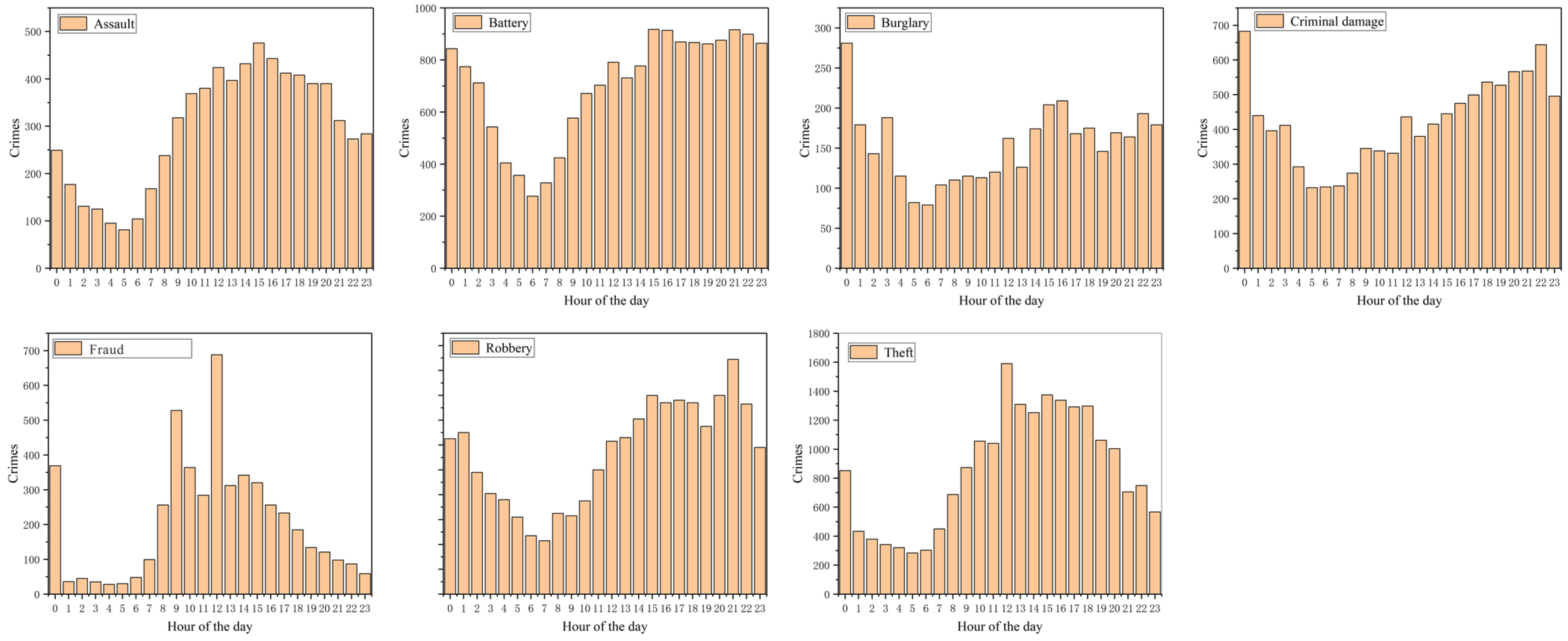
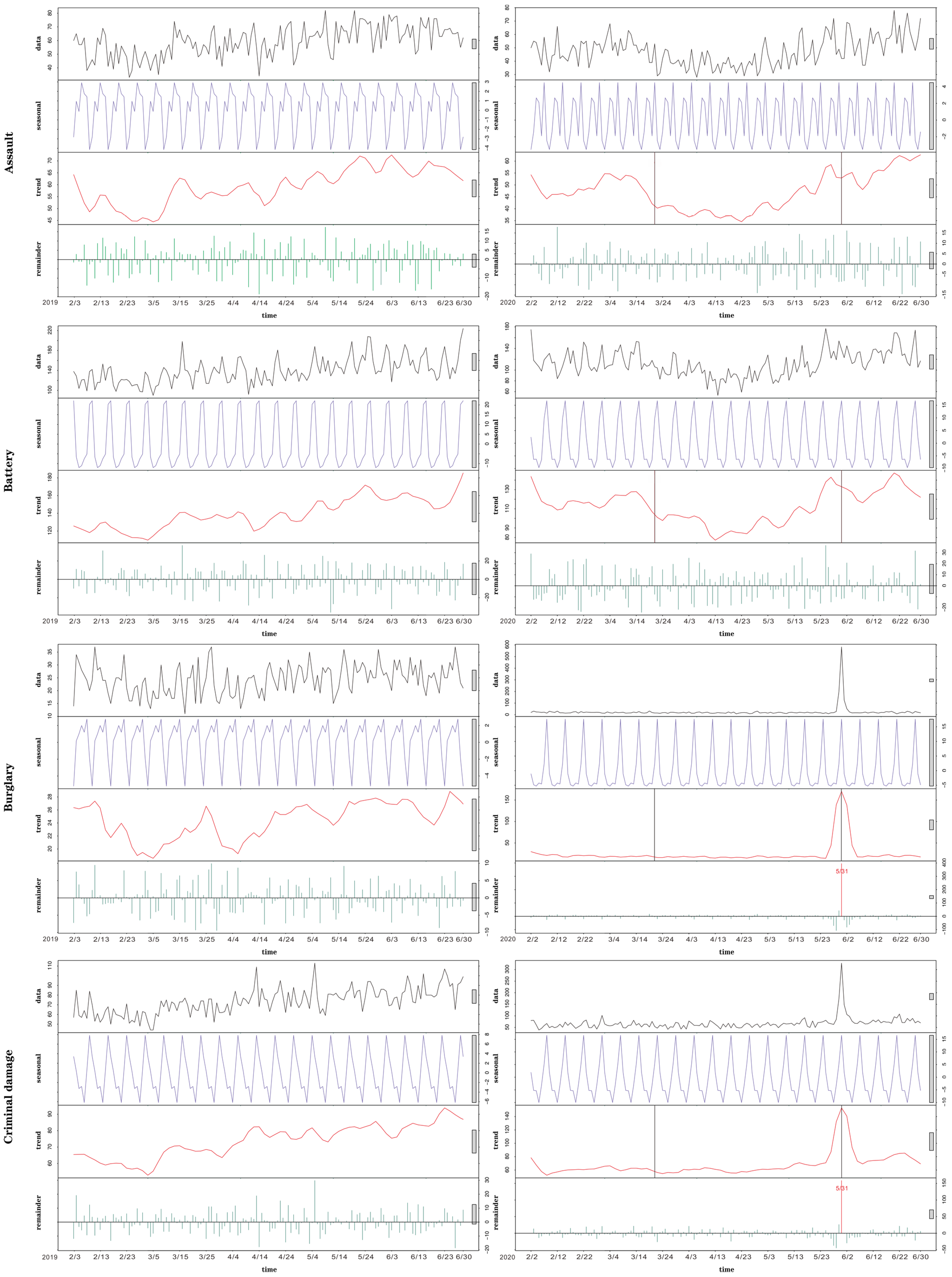
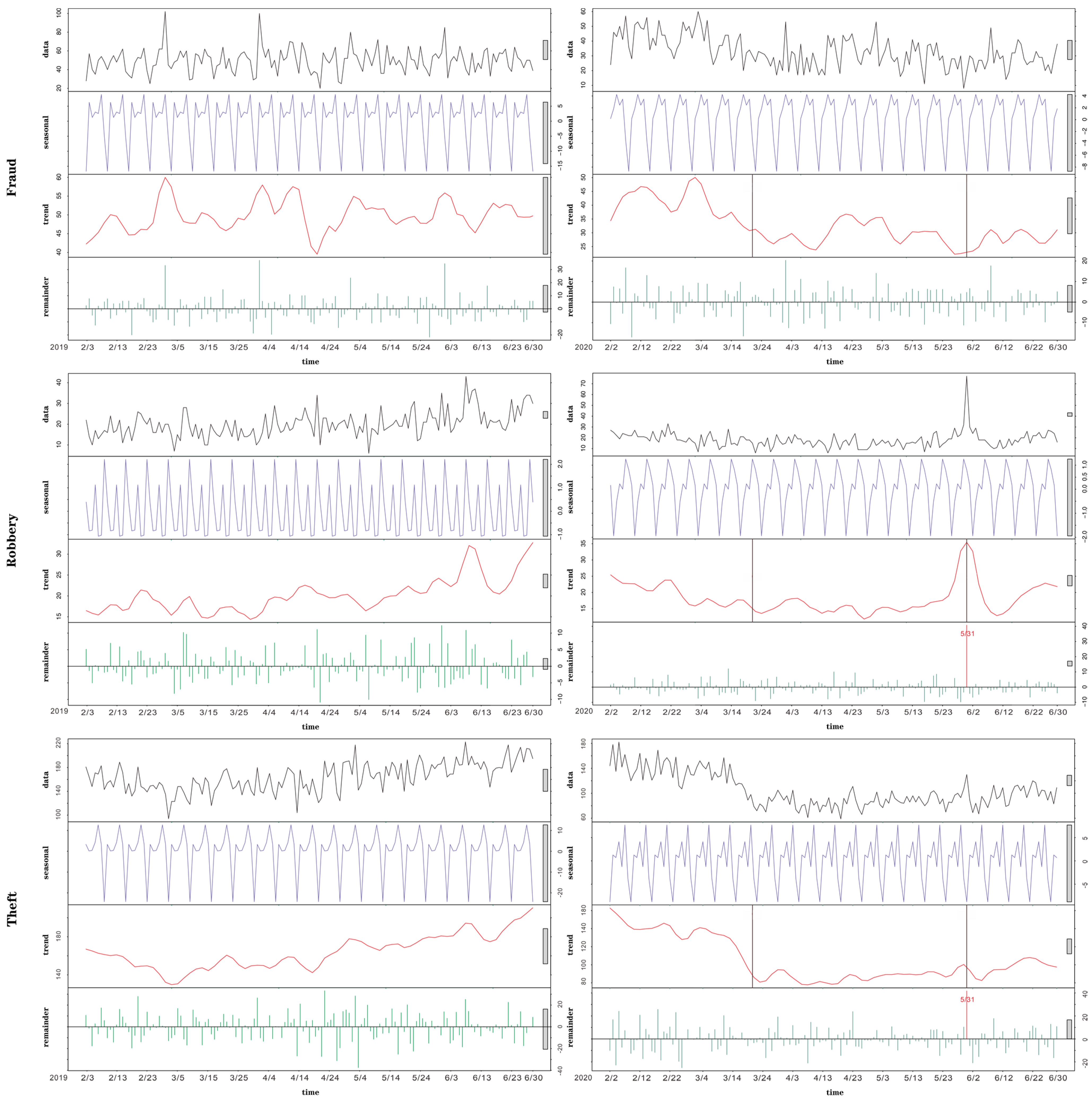
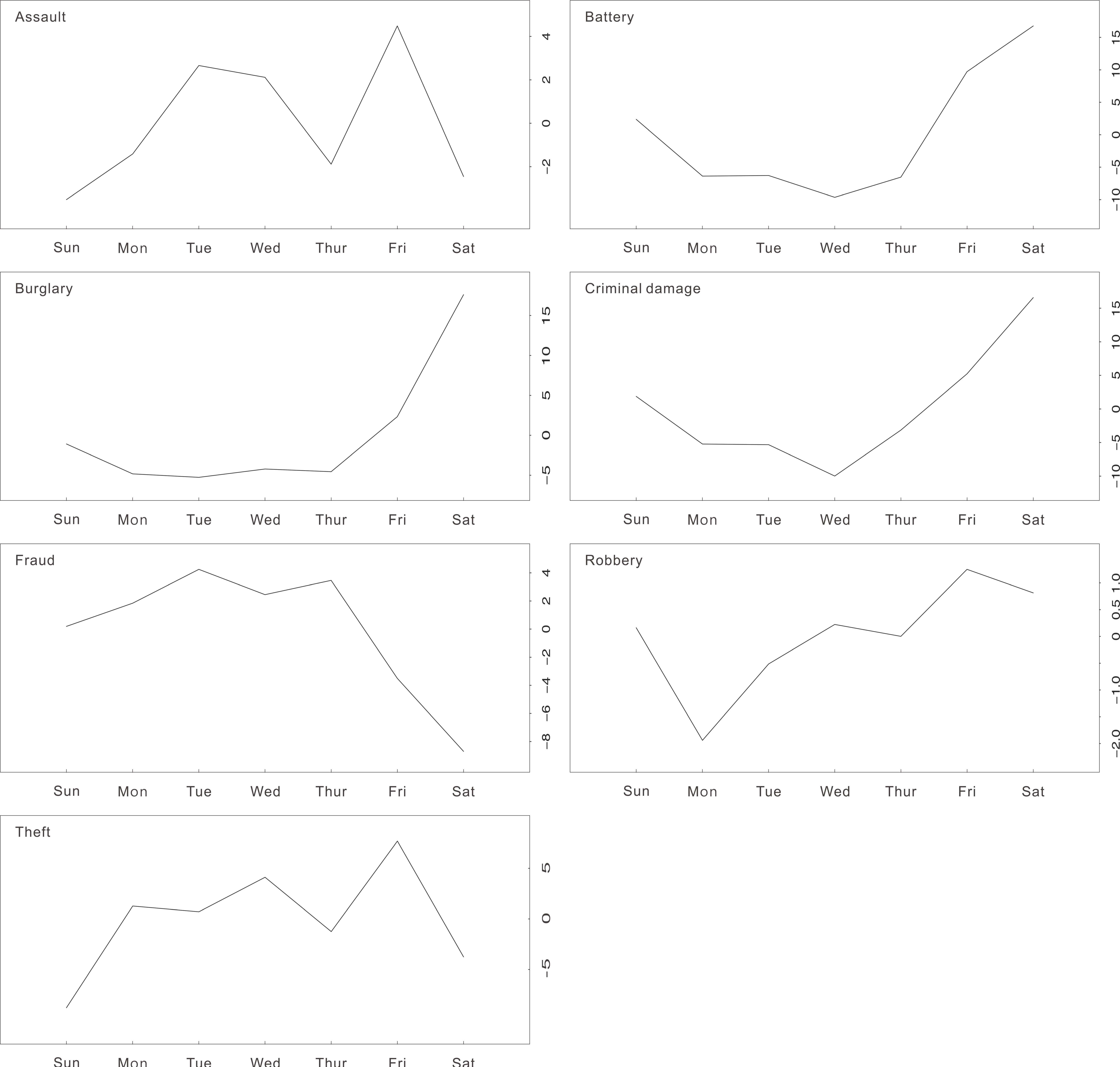
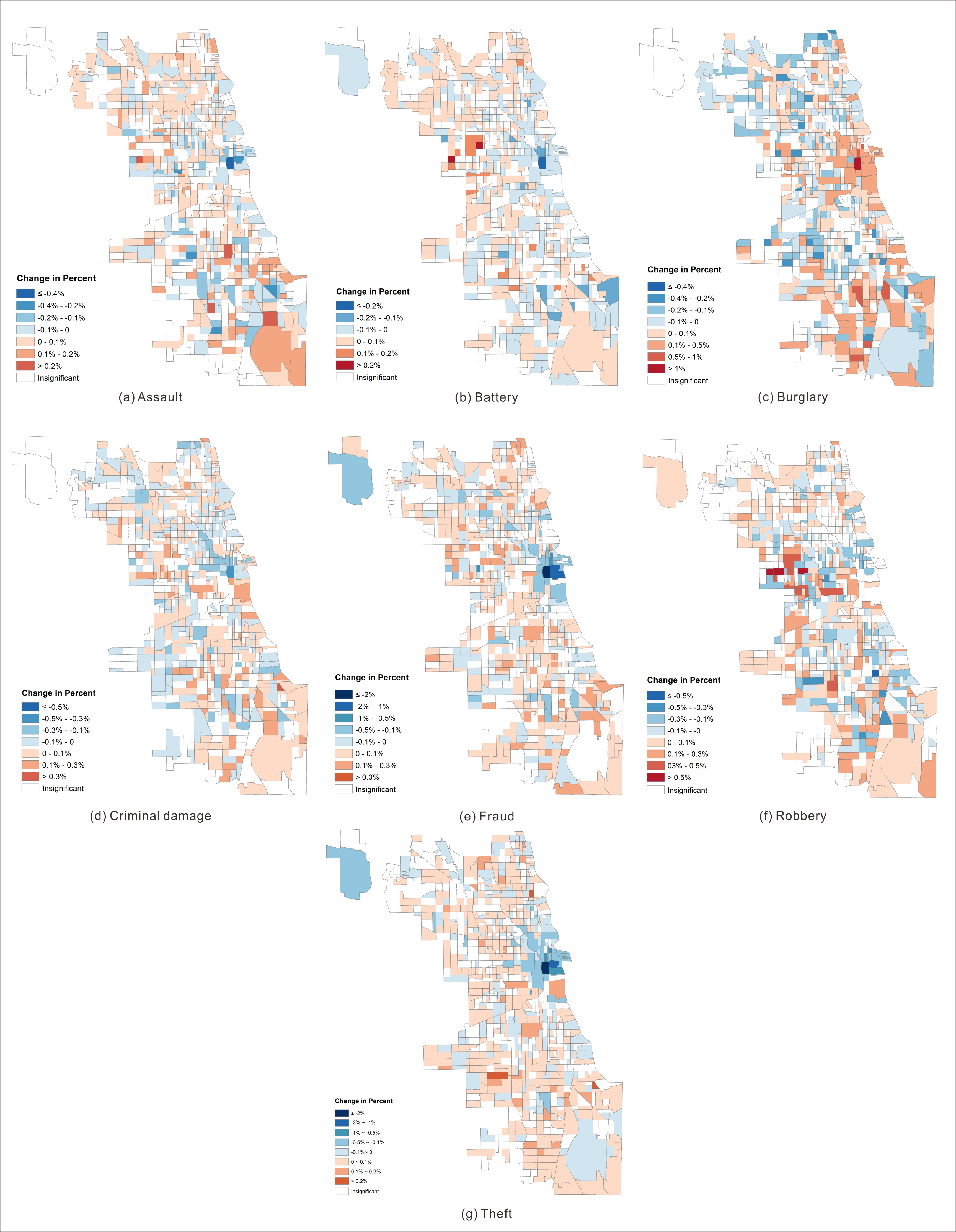

| Crime Type | Number of Crimes (2019) | Number of Crimes (2020) | Rate of Change |
|---|---|---|---|
| Assault | 8907 | 7217 | Decrease by 18.97% |
| Battery | 20,964 | 17,158 | Decrease by 18.15% |
| Burglary | 3660 | 3775 | Increase by 3.14% |
| Criminal damage | 11,094 | 10,368 | Decrease by 6.54% |
| Fraud | 7530 | 5338 | Decrease by 29.11% |
| Robbery | 3015 | 2788 | Decrease by 7.53% |
| Theft | 24,657 | 16,223 | Decrease by 34.21% |
| Crime Type | Statistic (Day) | p-Value (Day) | Statistic (h) | p-Value (h) |
|---|---|---|---|---|
| Assault | 0.5996 | p < 0.001 | 0.1083 | 0.2366 |
| Battery | 0.2383 | 0.0180 | 0.0941 | 0.3138 |
| Burglary | 9.2889 | p < 0.001 | 0.1222 | 0.1791 |
| Criminal damage | 8.5963 | p < 0.001 | 0.0674 | 0.5270 |
| Fraud | 0.1504 | 0.1026 | 0.0254 | 0.9729 |
| Robbery | 4.1132 | p < 0.001 | 0.0299 | 0.9417 |
| Theft | 1.5205 | p < 0.001 | 0.0260 | 0.9697 |
| Crime Types | Global Moran’s I | p-Value | Z-Score |
|---|---|---|---|
| Theft | 0.425 | 0.0003 | 24.711 |
| Battery | 0.126 | 7.981 × 10−11 | 6.396 |
| Burglary | 0.221 | 2.2 × 10−16 | 11.201 |
| Fraud | 0.429 | 2.2 × 10−16 | 23.839 |
Publisher’s Note: MDPI stays neutral with regard to jurisdictional claims in published maps and institutional affiliations. |
© 2021 by the authors. Licensee MDPI, Basel, Switzerland. This article is an open access article distributed under the terms and conditions of the Creative Commons Attribution (CC BY) license (http://creativecommons.org/licenses/by/4.0/).
Share and Cite
Yang, M.; Chen, Z.; Zhou, M.; Liang, X.; Bai, Z. The Impact of COVID-19 on Crime: A Spatial Temporal Analysis in Chicago. ISPRS Int. J. Geo-Inf. 2021, 10, 152. https://doi.org/10.3390/ijgi10030152
Yang M, Chen Z, Zhou M, Liang X, Bai Z. The Impact of COVID-19 on Crime: A Spatial Temporal Analysis in Chicago. ISPRS International Journal of Geo-Information. 2021; 10(3):152. https://doi.org/10.3390/ijgi10030152
Chicago/Turabian StyleYang, Mengjie, Zhe Chen, Mengjie Zhou, Xiaojin Liang, and Ziyue Bai. 2021. "The Impact of COVID-19 on Crime: A Spatial Temporal Analysis in Chicago" ISPRS International Journal of Geo-Information 10, no. 3: 152. https://doi.org/10.3390/ijgi10030152
APA StyleYang, M., Chen, Z., Zhou, M., Liang, X., & Bai, Z. (2021). The Impact of COVID-19 on Crime: A Spatial Temporal Analysis in Chicago. ISPRS International Journal of Geo-Information, 10(3), 152. https://doi.org/10.3390/ijgi10030152







